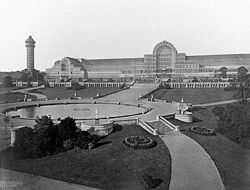| The Crystal Palace | |
|---|---|
 The Crystal Palace at Sydenham (1854) | |
 | |
| General information | |
| Status | Destroyed |
| Type | Exhibition palace |
| Architectural style | Victorian |
| Town or city | London |
| Country | United Kingdom |
| Coordinates | 51°25′21″N 0°04′32″W / 51.4226°N 0.0756°W |
| Completed | 1851 |
| Destroyed | 30 November 1936 |
| Cost | £80,000 (1851) (£9.3 million in 2024) |
| Design and construction | |
| Architect(s) | Joseph Paxton |
The Crystal Palace was a cast iron and plate glass structure, originally built in Hyde Park, London, to house the Great Exhibition of 1851. The exhibition took place from 1 May to 15 October 1851, and more than 14,000 exhibitors from around the world gathered in its 990,000-square-foot (92,000 m2) exhibition space to display examples of technology developed in the Industrial Revolution. Designed by Joseph Paxton, the Great Exhibition building was 1,851 feet (564 m) long, with an interior height of 128 feet (39 m),[1] and was three times the size of St Paul's Cathedral.[2]
The 60,000 panes of glass were manufactured by the Chance Brothers.[3] The 990,000-square-foot building with its 128-foot-high ceiling was completed in thirty-nine weeks. The Crystal Palace boasted the greatest area of glass ever seen in a building. It astonished visitors with its clear walls and ceilings that did not require interior lights.
It has been suggested that the name of the building resulted from a piece penned by the playwright Douglas Jerrold, who in July 1850 wrote in the satirical magazine Punch about the forthcoming Great Exhibition, referring to a "palace of very crystal".[4]
After the exhibition, the Palace was relocated to an open area of South London known as Penge Place which had been excised from Penge Common. It was rebuilt at the top of Penge Peak next to Sydenham Hill, an affluent suburb of large villas. It stood there from June 1854 until its destruction by fire in November 1936. The nearby residential area was renamed Crystal Palace after the landmark. This included the Crystal Palace Park that surrounds the site, home of the Crystal Palace National Sports Centre, which was previously a football stadium that hosted the FA Cup Final between 1895 and 1914. Crystal Palace F.C. were founded at the site and played at the Cup Final venue in their early years. The park still contains Benjamin Waterhouse Hawkins's Crystal Palace Dinosaurs which date back to 1854.
- ^ "The Crystal Palace of Hyde Park". Archived from the original on 12 March 2012. Retrieved 4 April 2008.
- ^ James Harrison, ed. (1996). "Imperial Britain". Children's Encyclopedia of British History. London: Kingfisher Publications. p. 131. ISBN 0-7534-0299-8.
- ^ Chance, Tom. "The Crystal Palace's glass" (PDF). Retrieved 31 March 2023.
- ^ The Punch issue of 13 July 1850 carried a contribution by Douglas Jerrold, writing as Mrs Amelia Mouser, which referred to a palace of very crystal. Michael Slater (2002). Douglas Jerrold. London: Duckworth. p. 243. ISBN 0-7156-2824-0. In fact the term "Crystal Palace" itself is used seven times in the same issue of Punch (pages iii. iv, 154, 183 (twice), 214 (twice) and 224. It seems clear, however, that the term was already in use and did not need much explanation. Other sources refer to the 2 November 1850 Punch issue bestowing the "Crystal Palace" name on the design by Terry Strieter (1999). Nineteenth-Century European Art: A Topical Dictionary. Westport, CT: Greenwood Press. p. 50. ISBN 0-313-29898-X. (And "Crystal Palace". BBC. Retrieved 21 November 2007.
The term 'Crystal Palace' was first applied to Paxton's building by Punch in its issue of 2 November 1850
.) Punch had originally sided with The Times against the exhibition committee's proposal of a fixed brick structure, but featured the Crystal Palace heavily throughout 1851 (for example in "Punch Issue 502". Archived from the original on 20 April 2006. included the article "Travels into the Interior of the Crystal Palace" of February 1851). Any earlier name has been lost, according to "Everything2 Crystal Palace Exhibition Building Design #251". 2003.. The use by Mrs Mouser was picked up by a reference in The Leader, no. 17, 20 July 1850 (p. 1): "In more than one country we notice active preparations for sending inanimate representatives of trade and industry to take up their abode in the crystal palace which Mr. Paxton is to build for the Exposition of 1851." Source: British Periodicals database or Nineteenth Century Serials Edition Archived 17 April 2009 at the Wayback Machine